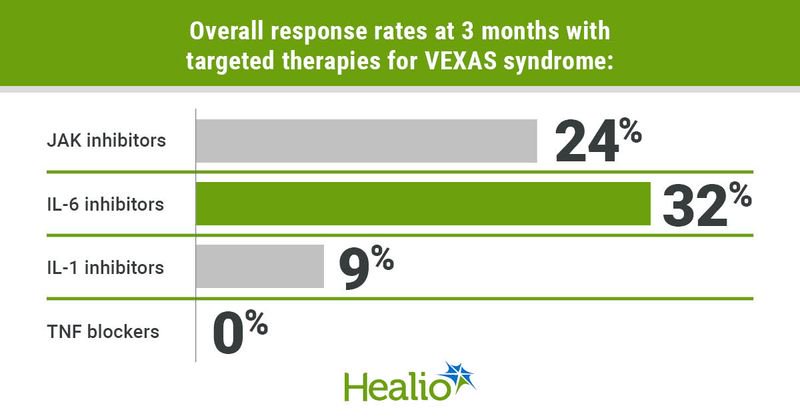JAK, IL-6 inhibition most effective targeted therapies for VEXAS syndrome
Click Here to Manage Email Alerts
Key takeaways:
- Among targeted therapies, patients with VEXAS syndrome responded most overall to JAK inhibitors and IL-6 blockers.
- JAK inhibitors conferred significantly longer survival without treatment discontinuation.
The most efficacious targeted therapies for VEXAS syndrome are Janus kinase inhibitors and interleukin-6 inhibitors, while IL-1 and TNF blockers are less effective, according to data published in the Annals of the Rheumatic Diseases.
“Due to its recent description, the therapeutic management of patients with VEXAS is not based on high-quality data, and current evidence comes mostly from small retrospective studies,” Jerome Hadjadj, MD, PhD, of Hopital Saint-Antoine, in Paris, and colleagues wrote. “There are currently no comparative studies between different therapies and no codified therapeutic strategy.”

To learn more about effective treatments for VEXAS — or vacuoles, E1 enzyme, X-linked, autoinflammatory and somatic — syndrome, Hadjadj and colleagues conducted a multicenter, retrospective study of the French national VEXAS registry. The study included 110 adults with VEXAS syndrome (median age, 71 years) who received at least one targeted therapy between November 2020 and August 2023. These therapies included JAK inhibitors (40%), IL-6 inhibitors (26%), IL-1 inhibitors (17%) and TNF blockers (10%).
The primary outcome was complete response, defined as clinical remission, a C-reactive protein (CRP) level of 10 mg/L or less and receiving 10 mg per day or less of prednisone-equivalent therapy. Partial response — defined as clinical remission and a 50% reduction in CRP and glucocorticoid dose — was a secondary outcome.
At 3 months, the combined complete and partial response was highest among patients who received JAK inhibitors (24%) and IL-6 inhibitors (32%), and lowest in those treated with IL-1 inhibitors (9%) and TNF blockers (0%). According to the researchers, overall response with JAK inhibitors and IL-6 inhibitors rose to 30% and 26%, respectively, at 6 months.
JAK inhibitors yielded significantly longer survival without treatment discontinuation — a median of 7.3 months — compared with IL-6 inhibitors, which demonstrated a median survival of 5.2 months, IL-1 inhibitors, which had a median of 1.1 months, and TNF blockers, which resulted in a median of 3.8 months.
The study’s limitations include its retrospective design and uneven sizes of treatment arms, the researchers wrote.
“Thus, prospective studies would be needed to further examine the safety and efficacy of targeted therapies in VEXAS syndrome,” Hadjadj and colleagues wrote. “In this complex and heterogeneous disease, these trials would make possible to randomize patients to the various treatment options, to standardize the dosing regimens between individual investigators and centers and the collection of laboratory data for each treatment group, to control the order of treatment options and to use consensual and validated response criteria.
“This study confirms the benefit of JAKi and IL-6 inhibitors, whereas the other targeted therapies appear to be less effective,” they added. “These results need to be confirmed in prospective therapeutic trials.”
